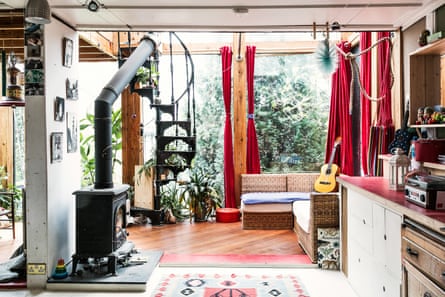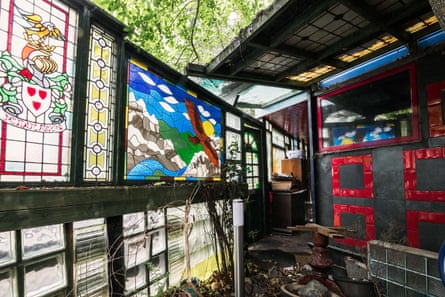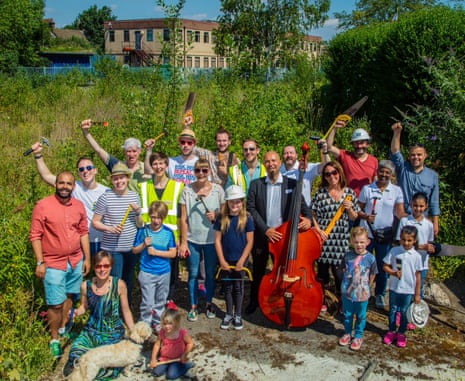“Federico, I’m terrified. I’m terrified of heights. I don’t know how to do it.” Federico Mazandarani is recalling a time in the mid-80s when he was one of 13 households building their own houses in what would be named Walters Way in Lewisham, London. It was time to do the capping on roofs and one of his neighbours, a taxi driver called Jim, found his nerve failing him. “You’re lonely, you’re on your own,” Mazandarani recalls answering, “I have the same problem. Why don’t I help with your capping for one week and you help with mine for one week.” After that, “he was a changed man”.
It is stories like this that explain the enduring fascination of Walters Way, 30 years old this year, and its sister development, about a mile away in the same borough, Segal Close. Both are celebrated in a new book, written by one resident, Alice Grahame, and photographed by another, Taran Wilkhu, with an accompanying event at the Building Centre in London. They draw crowds every year at Open House weekend and are the objects of pilgrimages by architecture students. The reason is that they are inspiring realisations of the ideas of the architect Walter Segal, who believed that if you could cut a straight line in a piece of wood, you could build your own home. He therefore devised techniques to simplify construction such that people would not only get a beautiful and cheap house, but also have their lives changed. “Nobody will be able to tell me that I can’t do something ever again,” said one.
Everyone loves Segal’s developments and everyone loves the idea of self-build. Its popularity crosses political boundaries and so gets championed by all parties. For Mazandarani it is a “communist” project. It was a Labour council that made Walters Way and Segal Close possible, but there is also something of the crossover of anarchism and early Thatcherism in the notion that ordinary people should be empowered to make their own home. Last year, the Conservative government enacted legislation to encourage self-building.

Yet it remains a niche, accounting for a tiny proportion of the 200,000 or so new homes that Britain is supposed to need per year, and of the smaller number that actually gets built. It is a niche populated by passionate and dedicated enthusiasts, who communicate through rough-edged websites. Out of the self-build movement emerge, not always easily, singular developments like the Hedgehog Housing Co-op in Brighton and Ashley Vale in Bristol. Segal’s former collaborator Jon Broome has successfully realised a number of self-build homes over the years. But the approach is a long way from meaningfully helping to address the country’s housing shortages. The question is, why?
There are, in fact, many forms of self-building. There is the Walter Segal way, where future residents wield tools and lift materials themselves, and there are the versions – more properly called custom build – where developers offer options for alternative layouts of houses that they then build, and there are companies selling prefabricated kits which allow a certain number of variations. There are those that Broome calls the “TV fantasists”, people with the money to pursue their personal dream, who get to star in shows like Grand Designs. There are cases where people get together to form collaborative organisations to navigate the political and administrative labyrinths that get in the way of building a small community. In the case of Segal Close and Walters Way, the borough of Lewisham contributed land and central government contributed some funding, such that people from the council’s housing waiting list could get themselves a home by building it.
None of these methods are easy. An early headline calls Ashley Vale a “vale of tears”. Geoff Stow, a Walters Way self-builder who went to work as site manager on the Hedgehog Housing Co-op and other projects, says that “it’s a bit like having a kid – it’s all-encompassing.” Some relationships didn’t survive the pressures.
Stow also cites both high land costs and the crushing bureaucracy of financing, planning and regulations that means it can take years before construction even starts. The Rural Urban Synthesis Society, a community land trust set up by Kareem Dayes, the son of two Walters Way pioneers, is managing, with the help of Jon Broome, to realise a development of 33 homes elsewhere in Lewisham. But it took five years to get to this point and the fact that the development is four storeys high makes it harder to use amateur labour than on the two-storey Walter’s Way.

It doesn’t make it any easier that buildings are now expected to perform better in terms of things like thermal insulation. Segal’s houses “are a bit drafty”, says Alice Grahame, “he just thought you should put another sweater on if you got cold”. Now they have to be airtight and thickly insulated, which tends to work against the simplicity of his concepts. Health and safety, for which a certain disregard is evident in films of the construction of the original Segal projects, now adds to the complexity.
For all these reasons, the government’s backing of self-build has yet to bear much fruit. The Department for Communities and Local Government say that 18,000 aspiring self-builders have signed up to the register that the government has instituted, but they can’t say how many actual homes have been built. In Bicester, Oxfordshire, the government is supporting a development on old Ministry of Defence land, Graven Hill, on which it his hoped that 1,900 homes will be self-built, but it is taking a while to get off the ground.
Yet, as both Broome and Stow point out, community-led and self-built homes are commonplace in the Netherlands, Belgium and Germany. It would help very much if the tortuous processes of realising a home were simplified, and if there were established ways for self-builders to find their way through them. It would also help if government tipped the scales a little away from the volume house builders who dominate the market in land. Walters Way and Segal Close only happened because of the support of local and national government.

A visit to these places now shows why it’s worth the effort. As residents say, they feel like another world from the hard-faced streets of most of London, and the sense of community is palpable. The houses themselves are light-filled, and have the peacefulness that comes with timber construction. They are also hugely adaptable. One couple took a wall down so they could have a big party, and put it up again afterwards. Mazandarani’s house has been engulfed by his passion for stained glass. A treehouse has been added to another, such that it looks like an outgrowth of the original building. It is improvisational architecture, played out within the repeating staves of Segal’s original designs.
Now, of course, delightfulness comes at a cost, and houses that cost 20-odd thousand to build sell for £800,000 or so. The next generation deserves the chance of some of these pleasures too.
Walters Way and Segal Close by Alice Grahame and Taran Wilkhu is published by Park Books, €38 (£34). The authors will be in discussion with Jon Broome, John McKean and Tom Dyckhoff at the Building Centre, London WC1 on 24 July

Comments (…)
Sign in or create your Guardian account to join the discussion